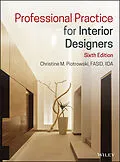The leading guide to the business practice of the interior design profession, updated to reflect the latest trends
For nearly thirty years, Professional Practice for Interior Designers has been a must-have resource for aspiring designers and practicing professionals. This revised and updated Sixth Edition continues to offer authoritative guidance related to the business of the interior design profession--from the basics to the latest topics and tools essential for planning, building, and maintaining a successful commercial or residential interior design business.
Filled with business tips and best practices, illustrative scenarios, and other pedagogical tools, this revised edition contains new chapters on interior design in the global environment, building client relationships, and online marketing communications. The author also includes updated information on web and social media marketing, branding, and prospecting for global projects. Recommended by the NCIDQ for exam preparation, this Sixth Edition is an invaluable resource for early career designers or those studying to enter the profession. This important book:
* Contains three new chapters that focus on client relationships, marketing communications, and interior design in the global marketplace.
* Includes new or updated sections that reflect the recent trends related to social media, branding, sustainable design practice and more
* Offers invaluable pedagogical tools in every chapter, including chapter objectives and material relevant for the NCIDQ
* Instructors have access to an Instructor's Manual through the book's companion website
Autorentext
CHRISTINE M. PIOTROWSKI, FASID, IIDA, provides consulting services to interior designers on business practices. She is a former professor of interior design at Northern Arizona University and has over thirty-five years of commercial and residential design experience. She is a two-time winner of the ASID/Polsky Prize. She is the author of Becoming an Interior Designer; Designing Commercial Interiors; Problem Solving and Critical Thinking for Designers; and Professional Practice for Interior Designers, all from Wiley.
Inhalt
Preface xv
Acknowledgments xvii
Part 1 The Profession 1
1. Interior Design as a Profession 3
Why Study Professional Practice? 4
What is a Profession? 5
Defining the Profession 6
Professional and Social Responsibility 7
Historical Overview 8
Interior Design Value 10
The Business of Interior Design 13
2. Professional Advancement 19
Educational Preparation 20
Internships 22
Lifelong Learning 23
Professional Certification 24
Licensing and Registration 26
Professional Associations 28
3. Going Global 37
Global Design Work 38
Professional Practice in a Global Market 39
Cultural Sensitivity 43
International Etiquette 45
Part 2 Career Paths 49
4. Where Do Designers Work? 51
How Do Designers Work? 52
Types of Work Environments 53
Collaboration 57
Expectations 58
Your First Job 59
OntheJob Strategies 62
Making a Career Change 62
5. Professional Options 67
A Personal Mission Statement 68
Personal and Professional Goals 69
Career Decisions 73
Design Career Specialties 74
6. The Job Search 85
The Search is On 86
Resumes 90
The Cover Letter 96
Portfolios 99
How Employers Review Resumes and Cover Letters 102
The Job Interview 103
Typical Interview Questions 107
Illegal Questions 109
FollowUp 110
Part 3 Professional Responsibility 115
7. Ethics and Professional Conduct 117
Ethical Standards 118
Ethics in the Business Environment 119
Professional Conduct 122
8. Legal Responsibilities 129
The Legal Environment of Interior Design Practice 130
Criminal Versus Tort Law 133
Negligence 134
Intentional Torts 136
Intellectual PropertyCopyright 138
Code Compliance 143
Part 4 Defining the Project 147
9. Project Compensation and Design Fees 149
Calculating the Billing Rate 150
Which Compensation Method? 152
Estimating Design Fees 153
Indirect Job Costs 156
Methods for Setting Design Fees 157
10. Preparing Design Contracts 169
Definition and Basic Elements of a Contract 170
Letter of Agreement or Contract? 175
Proposals Versus Contracts 176
Contract Form and the Statute of Frauds 177
Developing the Design Contract 179
Content Formalities 182
Interior Design Contracts: Content and Form 183
Performance and Breach 199
Termination by Agreement 202
Avoiding Contract Disputes 202
11. Trade Sources 207
Internet Sourcing 208
Manufacturers 208
Sales Representatives 209
Marts, Showrooms, and Market Centers 210
Local Showrooms 212
Retail Specialty Stores 212
Manufacturer's Dealers 212
Trades and Crafts Resources 213
Construction Contractors 214
Selecting Trade Sources 215
12. Product Pricing 221
Pricing 222
Pricing Terms 222
Discounts 224
Selling Prices 228
Deposits, Down Payments, and Retainers 231
Freight and FOB 233
Delivery and Installation Charges 234
Sales and Use Taxes 235
13. The Selling of Goods: The Uniform Commercial Code and Warranties 241
Historic Overview of the UCC 242
